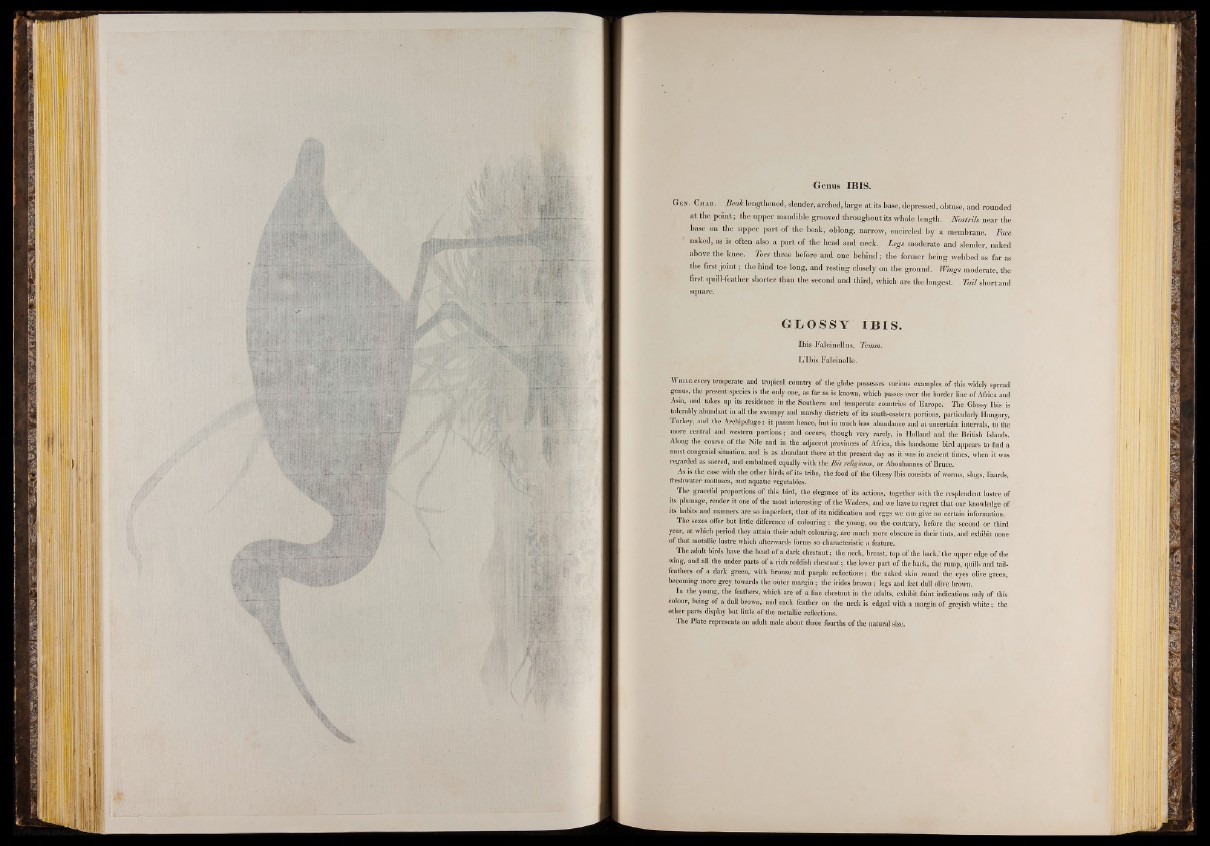
Genus IBIS.
Gen. Char. Beak lengthened, slender, arched, large at its base, depressed, obtuse, and rounded
at the point; the upper mandible grooved throughout its whole length. Nostrils near the
base on the upper part of the beak, oblong, narrow, encircled by a membrane. Face
naked, as is often also a part of the head and neck. Legs moderate and slender, naked
above the knee. Toes three before and one behind ; the former being webbed as far as
the first joint; the hind toe long, and resting closely on the ground. Wings moderate, the
first quill-feather shorter than the second and third, which are the longest. Tail short and
square.
GLOS SY IBIS.
Ibis Falcinellus, Temm.
L’Ibis Falcinelle.
W h il e every temperate and tropical country of the globe possesses various examples o f this widely spread
genus, the present species is the only one, as far as is known, which passes over the border line o f Africa and
Asia, and takes up its residence in the Southern and temperate countries o f Europe. The Glossy Ibis is
tolerably abiindant in all the swampy and marshy districts o f its south-eastern portions, particularly Hungary,
Turkey, and the Archipelago: it passes hence, but in much less abundance and at uncertain intervals, to the
more central and western portions; and occurs, though very rarely, in Holland and the British Islands.
Along the course o f the Nile and in the adjacent provinces o f Africa, this handsome bird appears to find a
most congenial situation, and is as abundant there at the present day as it was in ancient times, when it was
regarded as sacred, and embalmed equally with the Ibis religiosus, or Abouhannes o f Bruce.
As is the case with the other birds o f its tribe, the food o f the Glossy Ibis consists o f worms, slugs, lizards,
freshwater mollusca, and aquatic vegetables.
The graceful proportions o f this bird, the elegance o f its actions, together with the resplendent lustre of
its plumage, render it one o f the most interesting o f the Waders, and we have to regret that our knowledge of
its habits and manners are so imperfect, that o f its nidification and eggs we. can give no certain information.
The sexes offer but little difference o f colouring: the young, on the contrary, before the second or third
year, at which period they attain their adult colouring, are much more obscure in their tints, and exhibit none
o f that metallic lustre which afterwards forms so characteristic a feature.
The adult birds have the head of a dark chestnut; the iieck, breast, top o f the back,* the upper edge o f the
wing, and all the under parts o f a rich reddish chestnut; the lower part o f the back, the rump, quill- and tail-
feathers o f a dark green, with bronze and purple reflections; the naked skin round the eyes olive green,
becoming more grey towards the outer margin; the irides brown; legs and feet dull olive brown.
In the young, the feathers, which are o f a fine chestnut in the adults, exhibit faint indications oidy o f this
colour, being o f á dull brown, and each feather on the neck is edged with a margin o f greyish white; the
other parts display but little o f the metallic reflections.
The Plate represents an adult male about three fourths o f the natural size.